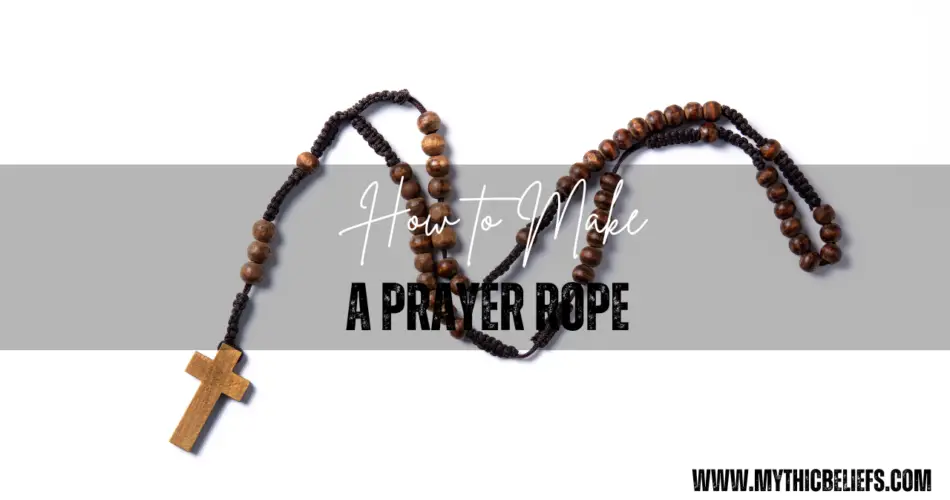There’s something deeply personal about making your own prayer rope. It’s more than just a craft—it’s a meditative practice, a way to bring prayer into the rhythm of your hands. Whether you’re looking to make a traditional Orthodox prayer rope (chotki), a simple Jesus prayer rope, or just something to help you focus during prayer, this guide will walk you through it.
How Are Prayer Ropes Made?
Prayer ropes have been around for centuries, used by monks, mystics, and everyday believers to help with prayer and meditation. Traditionally, they’re made by tying a series of intricate knots, each one a physical manifestation of prayer. The knots themselves are usually designed to be felt with your fingers, guiding your focus as you recite prayers like the Jesus Prayer (“Lord Jesus Christ, Son of God, have mercy on me, a sinner”).
Most prayer ropes are made in loops of 33, 50, or 100 knots, but you can adjust the number based on personal preference. Some also include divider beads or a cross at the end to signify the completion of a cycle.
What Is the Best Material for a Prayer Rope?
When choosing materials, comfort and durability are key. Here are some common options:
- Wool: Traditional Orthodox prayer ropes are made with black wool, symbolizing humility. Soft and durable, wool knots hold their shape well.
- Nylon or Silk Cord: These materials are great for beginners since they’re smooth and easier to work with. Plus, they last a long time.
- Paracord: A modern, durable alternative that works well for outdoor use or everyday carry.
- Beads: Some prayer ropes incorporate wooden or glass beads between knots for easier counting.
Whichever material you choose, make sure it feels good in your hands. If it’s uncomfortable, you won’t use it as often.
How to Make a Prayer Rope Knot
Now for the tricky part—the knot itself! Traditional Orthodox prayer ropes use a special type of knot called the “Jesus Knot” or “Komboskini Knot.” This knot isn’t just functional; it’s symbolic, representing the Trinity with multiple intertwined loops.
Here’s a basic way to tie it:
- Cut your cord – Start with a piece at least 4-5 feet long.
- Make a loop – Hold the cord and create a simple loop.
- Wrap the working end – Wrap it around your finger or a small dowel several times (usually 7-9 times for a traditional knot).
- Weave the end through the loops – Carefully thread the end of the cord back through the loops, creating a tight, rounded knot.
- Tighten and adjust – Pull slowly to tighten, making sure the knot holds its shape.
- Repeat – Continue tying until you reach the desired number of knots.
If this sounds complicated, don’t worry! It takes practice. Many monks spend years perfecting the technique, so don’t be too hard on yourself if your first attempt is a little lopsided.
How to Make a Chotki Prayer Rope
A chotki is a specific type of Orthodox prayer rope, often with 33, 50, or 100 knots. To make one:
- Choose your material – Wool is traditional, but nylon works too.
- Tie your knots – Use the Jesus Knot method for consistency.
- Add dividers – Small beads or a slightly larger knot every 10 knots can help with counting.
- Finish with a cross – Many chotkis end with a simple knotted cross or a small metal cross attached.
- Pray as you go – Many people pray while making their prayer rope, turning the entire process into a meditative practice.
How to Make a Prayer Rope Orthodox Style
For a traditional Orthodox prayer rope:
- Use black wool (symbolizing repentance and humility).
- Make knots in multiples of 33, 50, or 100.
- Follow the Jesus Knot technique for authenticity.
- Include a cross at the end, either knotted or wooden.
- Some Orthodox prayer ropes also include divider beads every 25 knots.
If you’re serious about tradition, you can even have your prayer rope blessed by a priest before using it.
How to Make a Jesus Prayer Rope
If you’re looking for a simpler alternative, a Jesus Prayer rope can be made with fewer knots and a straightforward design. Here’s how:
- Choose a soft cord – Something comfortable for daily use.
- Decide on the number of knots – 10, 33, or 50 are great options.
- Tie each knot carefully – Aim for even spacing.
- Add a cross or tassel – This makes it easy to find the starting point.
Unlike Orthodox chotkis, these ropes don’t always follow the strict Jesus Knot technique and can use simple overhand or barrel knots instead.
Final Thoughts: A Prayer Rope Made with Intention
Making a prayer rope isn’t just about creating a useful tool—it’s about engaging in a spiritual practice. Every knot, every loop, is an opportunity to reflect, to pray, to center yourself.
If your first prayer rope turns out messy, don’t stress. The beauty is in the effort, not perfection. So grab some cord, start tying, and see where the journey takes you.
Have you ever made a prayer rope? Share your experiences in the comments!
